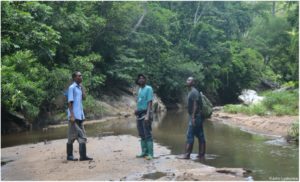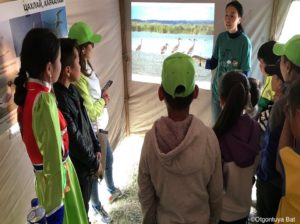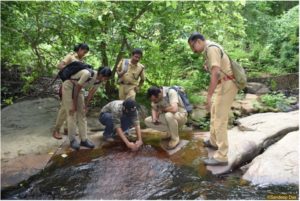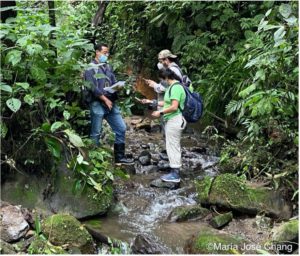With the deadline for the latest call for the next cohort of EDGE Fellows fast approaching, we decided to ask some of our current Fellows about their experience so far, what drives them and what advice they would give to future applicants.
What has been your favourite part about the EDGE fellowship so far?
María José – Nimble long-limbed salamander – c.2021-2023
“The contact with people from other countries and also how nice the staff are. I feel we made a connection with the other fellows. We have a WhatsApp group and sometimes people share their fieldwork pictures. It was a great idea because we can talk and be like ‘oh I’m so behind with the things we have to do’, and then you notice you’re not the only one. It also gives you another vision of how things are in the world.”

John, works on the turquoise dwarf gecko in Tanzania, said he most enjoyed the training in South Africa. Sharing experiences and solutions to conservation issues provides him with a broad picture about how things are going across the whole of Africa. He also said training from ZSL was very helpful, as he mapped his species himself, which is he very proud of.
Oko – Siberian crane – c.2019-2021
“My days in Borneo Island and Washington DC were the highlight of the fellowship because it was very exciting, and there are so many people who are concerned about the species, and also the biodiversity around the world, and it was like a mind opening moment.”
Rajkumar – Galaxy frog – c.2019-2021
“The risk assessment and emergency response plan part. It helped me a lot during the flood and landslides that happened in 2019 to change the field plans accordingly.”
Ayushi – Cantor’s giant softshell turtle – c.2019-2021
“I love my advisor, Fran. I have troubled her a lot because I’ve come up with so many stupid questions, and she has been so supportive and so calm throughout. She’ll always support me in any way possible because there had been difficult parts about the fellowship – I had to live all by myself in a place where I don’t know the language. I think she was one of the most stable and more constant and best part of the fellowship.”
What drives your interest in conservation?
María José – Nimble long-limbed salamander – Guatemala – c.2021-2023
“, where you do pure science, pure investigation, and give something back to people because conservation is not only for the animals – that they have the right to be conserved – but also for us as a species to have the chance to have a better life.”
John – Turquoise dwarf gecko – c.2020-2022
“We are losing a lot of animals from habitat destruction, illegal trade, climate change and other threats. Tanzania is one of the most threatened countries because, for example, we are losing about 300-400,000 hectares per year and we have only 1.1% of our land covered by a closed canopy forest. It concerns me a lot, keeping in mind that most of the amphibians and reptiles we have in our country, especially endemic ones, are forest specialists. We have very few people who are interested with amphibians and reptiles, and I think ‘I’m the one to do something to conserve them’.”
Oko’s drive stems from educating the younger generation. For the last three years, she has raised awareness about the Siberian crane in Mongolia. She enjoys the experience of combining the fields of science and education.
Rajkumar – Galaxy frog – Kerala, India – c.2019-2021
“Because of human activities and the current pace of extinction, it is really important to create awareness and build a conservation network or some interest in everyone’s mind towards nature or animals. The things we are getting from nature are supporting our well-being, so it is really important to understand that and protect what we have around us.”
Ayushi – Cantor’s giant softshell turtle – Kerala, India – c.2019-2021
“I think my focus has shifted a lot since I started this project. How it generally is, especially with Indian scientific community, is a lot of people like to work with research questions in conservation. So, when I started this project, I was like ‘okay I’m going to know a lot about ecological aspects of this turtle’ but when I came into it, I started looking a lot towards involving community in conservation.”
Lili – Dwarf gecko – Colombia – c.2018-2020
“People always have some scares about reptiles – they have many myths and beliefs that generate all these fears and I think that work in conservation of reptiles is really hard. It’s not easy to generate this engagement with people on those species and thinking about that made me feel that I need to do something to help people learn about this group.”
What are you most excited about for the future?
María José – Nimble long-limbed salamander – Guatemala – c.2021-2023
“I’m excited for everything! Maybe I am the most excited about the community contact. I actually didn’t think that was going to be one of the most exciting parts for me, because I’ve always been like the typical scientists that is like ‘oh I don’t like people’ *laughter*. But I’m really excited about that contact, with talking to people and having the workshops with children.”
Marina – Four EDGE frogs – c.2020-2022
“I am really excited to create a conservation mind for everybody to look at the population around the mountain. They are using chemical products around the different frog habitats. I’m trying to fight it and raise awareness about it. On my mountain there are more than 40 endemic species, and the mountain is even considered as the hotspot of herpetology, so it’s really important for us to protect all the endemic species on that mountain because if you protect the entire mountain, we will be sure to protect our EDGE species.”
Oko – Siberian crane – c.2019-2021
“I’m very excited to continue my work with the species. Also, we’re trying to work on White-necked crane, another species of crane in Mongolia, because their inhabited environment is actually very similar, so we’re trying to have a bigger more effective view of all the species of cranes in our country if possible.”
Rajkumar – Galaxy frog – Kerala, India – c.2019-2021
“I’m trying to figure out the threats faced by the animal. The local communities are really connected with the forest habitat. Slowly, we can reduce their dependence or deleterious activities by finding some other way of economical support besides lemon grass extraction, like making some handicraft or doing some other agriculture activities. Through that, we can also get support for conserving the habitat, so in maybe 10 or 20 years, we can have a stable population of galaxy frog.”
Ayushi – Cantor’s giant softshell turtle – Kerala, India – c.2019-2021
“I am looking forward to keeping working with this in future, and I hope I get a chance to work with this turtle, because I think there’s a lot of scope. I’m really, really excited to keep on working with EDGE people because they’re awesome. I couldn’t have done what I’ve done without them.”
What advice would you give a future EDGE Fellow?
María José – Nimble long-limbed salamander – c.2021-2023
“Just do it. Don’t be afraid. You have to believe in yourself. This is the first time Guatemala is in the programme and we are two girls so, yay! Women in science! Maybe we have this imposter syndrome, especially in Latin America, and people just get so scared of applying or participating and we tend to not believe in ourselves, so for me that’s the thing – just do it. You don’t lose anything by doing it. Get a nice advisor – I feel like that was an important part for me.”
Marina – Four EDGE frogs – c.2020-2022
“You as the new guys must be strong, you have to fight with nature, fight with the population, and when discussing with the population they have to understand what your work is. You cannot force people to help you conserve your species, so you have to explain to them, you have to be gentle with them, you have to understand their culture and then everything will be ok.”
John – Turquoise dwarf gecko – c.2020-2022
“I’ll tell them to be very careful when they are planning for their projects. Some things might sound very easy, but in the field, there are a lot of challenges. For example, we are working with species where trade is one of the things which is affecting the species, so sometimes there are some information which are very difficult to get. People are not very willing to share this very sensitive information, so we have to be very keen in planning. You can be so ambitious, and probably you will not be able to achieve everything with the time we have for the fellowship.”
Oko – Siberian crane – c.2019-2021
“Don’t give up. The beginning it was very hard, but then, with the help and support from EDGE programme and it was not impossible, it was possible. I would just say ‘don’t stop, keep moving forward’.”
Rajkumar – Galaxy frog – Kerala, India – c.2019-2021
“Seriously, you need to put in one hundred percent effort. We have to do several activities and we have to travel a lot; we have to communicate with the local communities and different stakeholders. It is not a simple task – you can’t really think ‘we can get money and we can submit some project reports’ – it’s not like that. We should be dedicated to do the work. If you are really thinking about applying for EDGE, you should really go through the species list and find your special one, make an attachment towards that species and try to apply. Then only you can come up with better, stronger objectives, and a better application. Our objectives and our question should be precise and good enough to protect that animal.”
Ayushi – Cantor’s giant softshell turtle – c.2019-2021
“I’ve grown up in a very hierarchical Indian society and even more hierarchical Indian education system, so a lot of us are scared to talk to people directly. Just talk to EDGE team and I think just go for it because there’s a lot of opportunities, especially for people who are just starting out and who don’t have any idea of how they should focus on a particular thing. I think it helps a lot in building your career as well as giving you a clearer idea of what you want to be because EDGE fellowship helps a lot to try out different things in different possible ways.”
Sandeep also recommends talking to the EDGE team before finalising your choice of species, as this helped him to shape his proposal for the purple frog in Kerala, India. He said, “most grants and applications will be an online system that submits straight away without much information about it, so EDGE’s support system is something really great.”
Luan – Botsford’s leaf-litter frog – c.2018-2020
“In Vietnam, as a non-English speaker, when we see the requirement of English Score is IELT 7.0, it is a big barrier to come over before thinking about any other project ideas. But if you can talk about your ideas, write down your ideas into a form in English even if they are not good looking, that is far enough. Please think about what you want to do, what species is your concern to work on, then contact the EDGE team, find an EDGE advisor, and talk about your ideas with them. You will find out that English is not a big problem.”
Kini – Hooded grebe – c.2015-2017
“They have to take advantage, not to think of the Fellowship as some money that they give you, but the whole network of people that is working on the EDGE program. These kind of human resources with a social scientist, with biologists in specialized in different areas of biology, with people that knows how to do fundraising stuff like that. I think that’s the key part of the fellowship – not the money, it’s the human part.”
In one word or short phrase, summarise your experience as an EDGE Fellow.
María José would describe the process so far as ‘exciting’, and she cannot wait to get started with her EDGE project!
Marina – Four EDGE frogs – c.2020-2022
“*laughing* Too much walking. Every month we have to do a report. But it’s fine, I think it is so exciting, it is a great experience.”
Oko – Siberian crane – c.2019-2021
“Amazing! I would never have imagined I can accomplish this, but it was amazing what I have been through so far.”
Rajkumar – Galaxy frog – Kerala, India – c.2019-2021
“It was a very excellent experience for me throughout. The collaborations with the EDGE team and EDGE Fellows are really awesome and the whole learning process is truly inspiring.”
Ayushi – Cantor’s giant softshell turtle – c.2019-2021
“Excellent! I don’t know if there’s any other words to describe it.”


